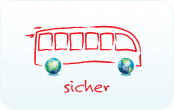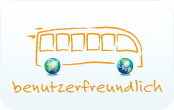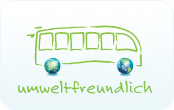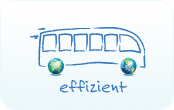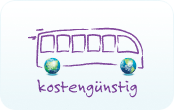|
Home  Beste Praktiken Beste Praktiken  Business managers Business managers
Information technologies
|
| | | // Real-time information to customers | 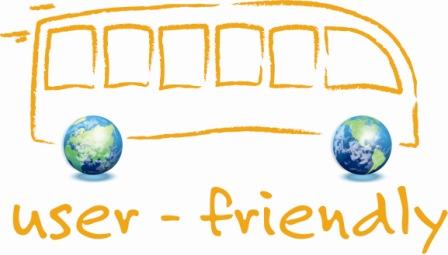 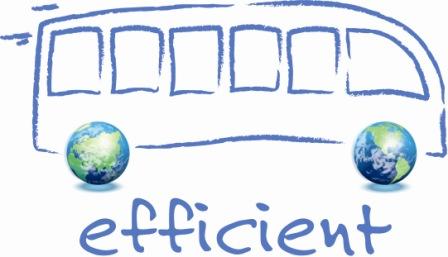 Real-time information available in terminals allows passengers to compare travel alternatives and to make the right transport choice in order to get to their destination in the most efficient way. Electronic displays, information screens and station announcements deliver this information. In case of delays, travel alternatives can be presented to passengers through these channels. Real-time information available in terminals allows passengers to compare travel alternatives and to make the right transport choice in order to get to their destination in the most efficient way. Electronic displays, information screens and station announcements deliver this information. In case of delays, travel alternatives can be presented to passengers through these channels.
Real-time information techniques have already been introduced in many cities throughout Europe, with an average passenger acceptance and appreciation level of 77%, i.e. in cities, such as Rome, Graz, Rotterdam and Berlin. Example: Graz provides of a real-time online presentation of the current traffic situation. Data from automatic traffic counters, taxis and traffic control optimisers are combined through a new model for data exploitation, which links data from various sources with each other. This collection of data provides essential information for operators and allows better short-term planning and ensures that faster action, including remedial action, can be taken. | For more information: Sustainable Urban Transport, Final report from the European project Trendsetter, pp. 26-28
http://www.civitas-initiative.org/docs1/CIVITAS_TRENDSETTER_Final_Policy_Report.pdf Traffic management, Workshop Graz, Trendsetter
http://www.trendsetter-europe.org/index.php?ID=3683 Mobitrans, l’information sur les bus et trams de Nantes en temps réel sur son mobile
http://www.altivis.fr/Mobitrans-l-information-sur-les.html Transports Publics Genevois (TPG) http://www.tpg.ch/ | // Online planning |   Online planning tools help passengers make the smart choice for their mode of transport. Itineraries, best connections and other alternatives can be checked on the web. Delays and the current traffic situation can be seen as well and included in the decision-making process of the mode of transport. Online planning tools help passengers make the smart choice for their mode of transport. Itineraries, best connections and other alternatives can be checked on the web. Delays and the current traffic situation can be seen as well and included in the decision-making process of the mode of transport.
Example: Graz and Stockholm have both developed websites to offer such services to their customers. In Graz, approximately 20% of customers of the Mobility Centre have changed their mobility behaviour in favour of collective/public transport. As a result, the Graz’s BusBahnBim website has contributed significantly to the increase in the number of people travelling by collective/public transport. | For more information: BusBahnBim-Auskunft, Graz AG Verkehrsbetriebe
http://www.gvb.at/ Sustainable Urban Transport, Final report from the European project Trendsetter, p.24
http://www.civitas-initiative.org/docs1/CIVITAS_TRENDSETTER_Final_Policy_Report.pdf Transports Publics Genevois (TPG) http://www.tpg.ch/ | // Localisation technologies & order bus services |   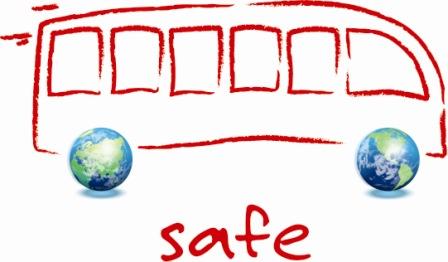 Localisation technologies, such as GPS, allow not only the development of warning and safety systems, but also provide important information to bus and coach passengers as well as to the drivers themselves. Localisation technologies, such as GPS, allow not only the development of warning and safety systems, but also provide important information to bus and coach passengers as well as to the drivers themselves.
In rural and sparsely populated areas, satellite navigation systems might be especially useful, when it comes to on-demand bus and coach services. Such systems are also effective in urban agglomerations. The integration of localisation technologies in mobile phones is another step towards the simplification of bus and coach services. Example: POSTBUS from Austria introduced such an ‘order bus service’ called BEHA-Points in rural areas of Austria. High-quality services are provided according to the actual demand of passengers. People can order the bus service either through pushing a button at BEHA-Terminals, or via SMS, Internet, phone or pre-ordering directly with the bus driver. The BEHA system has been broadly accepted by customers and a remarkable increase in cost-efficiency has been proven. In the city of Nantes, thanks to the MOBITrans passengers can obtain real-time information about the next two waiting times at bus and tram stations on their mobile phones. This allows passengers to better plan their time when taking public transport. | For more information: BEHA-Points: The flexible future for bus-stops, Postbus, IRU
http://www.iru.org/index/en_events_2005_eurochallenge_award_project Localisation par satellite et transports collectifs, Rapport de synthèse, ATEC-ITS France, pp.4-5
http://www.atec-tec.net/dossier/rencontrescongres/Rapport_Forum_100304.pdf Mobitrans : l’information sur les bus et trams de Nantes en temps réel sur son mobile, ALTIVIS
http://www.altivis.fr/Mobitrans-l-information-sur-les.html MOBITrans, un service innovant et gratuit d’information trafic en temps réel sur téléphone portable, Transdev
http://www.transdev.eu/Images/UploadPresse/Mobitrans.pdf Green paper on satellite navigation applications, European Commission, pp.4-6
http://eur-lex.europa.eu/LexUriServ/site/en/com/2006/com2006_0769fr01.pdf |
// Low-carbon vehicles | 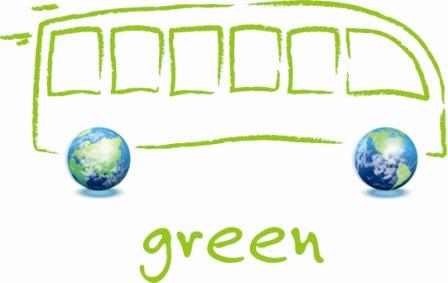 The introduction of low-carbon vehicles supports the decrease of fuel consumption.Various low-carbon technologies include hybrid buses, lighter vehicles, hydrogen and electric buses and coaches. The introduction of low-carbon vehicles supports the decrease of fuel consumption.Various low-carbon technologies include hybrid buses, lighter vehicles, hydrogen and electric buses and coaches. Example: In the UK, the Green Bus Fund is a new GBP 30 million fund from which bus and coach companies and local authorities can compete for funds to help them purchase new low-carbon buses. Its main purpose is to support and hasten the introduction of hundreds of low-carbon buses across England. | For more information: Greener Journeys, Make the switch to bus and coach, p.2
http://www.arrivabus.co.uk/uploadedFiles/Resources/Global/Greener%20Journeys%20pamphlet.pdf CIVITAS in Europe, A proven framework for progress in urban mobility, p.6
http://civitas.eu/docs1/CIVITAS_D8_Final.pdf Green Bus Fund, http://www.dft.gov.uk/pgr/regional/buses/greenbusfund/ | | | // Usage of renewable energy and alternative fuels |  Biodiesel, ethanol and biogas represent the main bio-fuels which are currently available. All three bio-fuels produce less CO2 emissions than traditional fuels. Biodiesel, ethanol and biogas represent the main bio-fuels which are currently available. All three bio-fuels produce less CO2 emissions than traditional fuels. Example: In the city of Graz the majority of biodiesel is produced by rapeseed oil, but nevertheless a considerable amount of used cooking oil is converted into biodiesel. Used cooking oil is collected from about 250 restaurants in Graz, benefiting the restaurants as well, through not paying the disposal fee. Furthermore, used cooking oil is also collected from households. The cooking oil is filtered and injected in the ordinary production line of biodiesel. Graz was able to collect 260 tonnes of used cooking oil in 2006, which was converted into enough biodiesel for the operation of 26 buses for the entire year. The city of Lille produces biogas from household waste, which is used to power 128 of the city’s bus fleet. | For more information: Sustainable Urban Transport, Final report from the European project Trendsetter, p.36
http://www.civitas-initiative.org/docs1/CIVITAS_TRENDSETTER_Final_Policy_Report.pdf CIVITAS in Europe, A proven framework for progress in urban mobility, p.10
http://civitas.eu/docs1/CIVITAS_D8_Final.pdf What European framework for a sustainable urban transport, Green paper on urban transport, Position paper, UITP, p.4 www.uitp.org/mos/positionspapers/31-en.pdf London congestion charging http://www.tfl.gov.uk/assets/downloads/sixth-annual-impacts-monitoring-report-2008-07.pdf | // POSTBUS - An innovative call system (IRU Eurochallenge 2005 award winner) | 

Read more about ÖBB-Postbus GmbH on the web | // Calgary improves services through new technology
|   Calgary Transit is among the first Canadian major urban systems to make use of new technology, such as the online look-up schedules and trip planning tools. SMS notifications already provide users with instant messages about delays or new services and now new technology will help in service management and ticketing too. Calgary Transit is among the first Canadian major urban systems to make use of new technology, such as the online look-up schedules and trip planning tools. SMS notifications already provide users with instant messages about delays or new services and now new technology will help in service management and ticketing too.
Because it makes 100 million annual passenger trips (there are nearly 1,000 buses) with more expected in the near future, Calgary Transit needed a more capable and scalable way to manage it all. Calgary Transit has therefore become among the first Canadian major urban systems to make use of new technologyfor use by customers when planning their route. SMS notifications already provide users with instant messages about delays or new services. A smart card ‘intelligent payment’ system is coming this summer. But, as part of a major new contract with a technology giant, Calgary Transit is also going to roll out a full computer-aided dispatch and automatic vehicle location system. By combining GPS, cellular, interactive displays and other tech tools, location tracking capabilities for vehicles will improve while enhancing support for operators to communicate in real-time. | For more information: http://www.calgaryherald.com/Calgary+Transit+gets+high+tech+boost+schedules+timetables/6542339/story.html#ixzz1uvmyEpQp | // New online travel planner in Basque region
|   The Basque region of Spain has introduced a new online travel planning portal for combined public transport modes that could potentially be reproduced worldwide as a key mobility enabler. The Basque region of Spain has introduced a new online travel planning portal for combined public transport modes that could potentially be reproduced worldwide as a key mobility enabler.
The smart move campaign supports any modern information system that can help passengers find the right bus or coach at the right time, and the Basque autonomous regional government and i2MApp, an Intelligent Transport Systems (ITS) provider, have jointly produced an integrated public transport portal that allows users to plan their journeys using information from 34 transport operators including, urban and intercity buses, metro, tram, rail, boats, ferries, hanging bridges and even elevators. i2MApp is working on a similar online travel planner with officials in Chile that brings together 29 transport operators and would help Chilean passengers optimise their use of public transport. | // Multi-modal travel info app expands to other smartphone networks
|   Multi-modal travel information via a smartphone has been extended in Scotland and Wales with the launch of two new apps for Blackberry and Android, showing live and scheduled bus times at selected stops. Multi-modal travel information via a smartphone has been extended in Scotland and Wales with the launch of two new apps for Blackberry and Android, showing live and scheduled bus times at selected stops.
The apps cover the whole of Scotland and Wales and are personalised and location-aware. Users can browse a map and click on stops to see live and scheduled bus times.
Other features include road traffic updates, multi-modal journey planning, local taxi numbers and live news updates. Built from a common product core, the apps have been adapted to the specific requirements of each implementation.
These new releases complement existing iPhone apps already available in both countries and an Android app launched in Scotland earlier this year. The joint Traveline Scotland /Traffic Scotland app is now available from BlackBerry App World, and a bilingual Traveline Cymru/Wales app is also available on the Android Market. | // Tiramisu
|   Tiramisu, a new iphone application, allows bus riders in Pittsburgh, USA,to track their current location while riding the bus and, in turn, share this information with people who are still waiting, thereby creating a more complete map and schedule of bus routes and times. Tiramisu, a new iphone application, allows bus riders in Pittsburgh, USA,to track their current location while riding the bus and, in turn, share this information with people who are still waiting, thereby creating a more complete map and schedule of bus routes and times. The app requires that the rider activate the tracker in order to see when the next bus is due to arrive as well as its current “fullness", which can be registered by riders. When he or she boards, the application sends the bus’ location to the main server so other riders can tell where that particular bus is and when it will arrive. This same data can eventually be used by the city or county transit authorities to improve travel times and inform riders of slow buses. It allows cash-strapped transit systems to add GPS functionality to their lines. “While better funded transit systems, such as those in Chicago, Seattle and San Francisco, can afford to make GPS-based information available to riders in real-time, the Allegheny County system is under tremendous budget pressure,” Steinfeld said. “Under such circumstances, a free, crowdsourced system such as Tiramisu offers an important alternative.” | For more information:
Download tiramisu ? http://techcrunch.com/2011/07/28/kiss-me-on-the-bus-this-app-crowdsources-bus-locations/ |
|
|
|
|
|
|
|
